Variation
Males have the upper forewings irrorated (sprinkled) with black scales at the apex and anteriorly along the termen, much more sparsely and narrower in general than in A. paulina. On the underside, the apex of the forewing and the whole surface of the hindwing are pale dull ochraceous, sometimes with a faint pinkish tint, but never pale yellow as in A. paulina. [3]
The sexes are dimorphic; the females differ as follows:
1st form: On the upperside, the posterior tornal portion of the black area on the forewing is not inwardly rounded, but straight and generally diffuse. The underside is very like the underside of the dry-season form of A. paulina female. It differs, however, in the narrowness of the oblique curved black band, the outer margin of which is irregularly zigzag, and never evenly curved as in A. paulina. [3]
2nd form: Markings as in the 1st form, but the ground colour on the upperside is entirely pale yellow. On the underside, the apical half of the cell and the disc of the forewing up to the black band are pale sulphur yellow. The oblique curved black band is as in the 1st form and the interspace 1 is whitish. The rest of the forewing and the entire surface of the hindwing are rich chrome yellow. [3]
The antennae, head, thorax and abdomen are much as in A. paulina, but the antennae are dusky black and more closely speckled with white; the underside of the thorax is white in males, never yellow. [3] [4]
Upper and undersides: similar to that of the wet-season specimens, but in the male the dusting of black scales on the upperside has almost, in some specimens completely, disappeared, while on the underside the ochraceous colouring is much paler. [3]
In the females both dimorphs differ but little from the dimorphs of the wet-season form, only on the upperside the black on the apical half of the forewing and on the terminal margin of the hindwing is more restricted, while on the underside the oblique curved black band that crosses the forewing is distinctly narrower with a tendency to become diffuse. [3]
The wingspan is 60–74 mm.
It is found in Sikkim up to 4,000 feet (1,200 m), Bengal, western and southern India. Also extending into north-eastern India, Burma and the Malay peninsula. [3]
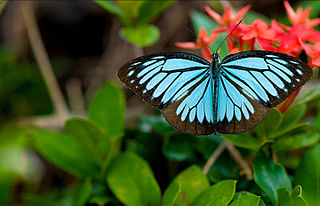
Pareronia valeria, the common wanderer or Malayan wanderer, is a medium-sized butterfly of the family Pieridae, that is, the yellows and whites, and is found in India and Southeast Asia. The butterfly found in India is sometimes considered as a separate species, Pareronia hippia.

Belenois aurota, the pioneer or pioneer white or caper white, is a small to medium-sized butterfly of the family Pieridae, that is, the yellows and whites, which is found in South Asia and Africa. In Africa, it is also known as the brown-veined white, and is well known during summer and autumn when large numbers migrate north-east over the interior.

Luthrodes pandava also called the Plains Cupid or cycad blue, is a species of lycaenid butterfly found in South Asia, Myanmar, United Arab Emirates, Indochina, Peninsular Malaysia, Singapore, Taiwan, Java, Sumatra and the Philippines. They are among the few butterflies that breed on cycads, known for their leaves being toxic to most vertebrates.
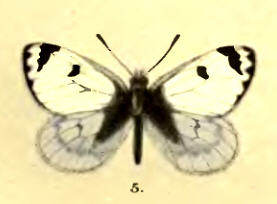
Baltia shawi, the Shaw's dwarf, is a small butterfly of the family Pieridae, that is, the yellows and whites. It is found at high altitudes in Central Asia.
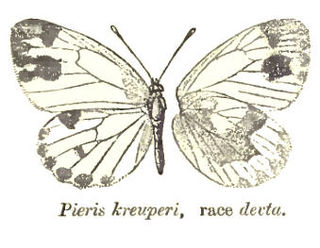
Pieris krueperi devta, the green-banded white, is a small butterfly of the family Pieridae, that is, the yellows and whites. It is found in India and Pakistan. It is a subspecies of Krueper's small white.

Ixias pyrene, the yellow orange tip, is a small butterfly of the family Pieridae, that is, the yellows and whites, which is found in Sri Lanka, India and southeast Asia.

Colotis amata, the small salmon Arab, is a small butterfly of the family Pieridae, that is, the yellows and whites. It is found in Africa and Asia. Adults are fond of smaller flowers for nectar and often fly low along the ground in search of wildflowers.

Colotis vestalis, the white Arab, is a small butterfly of the family Pieridae, that is, the yellows and whites, which is found in India, Pakistan, Iran, Somalia, Ethiopia, Sudan, Kenya and Tanzania. It has a wingspan of 4–5 cm.

Colotis etrida, the little orange tip, is a species of butterfly in the family Pieridae. It is native to India, Sri Lanka and Pakistan.
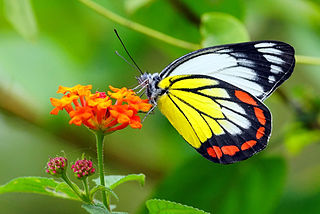
Delias hyparete, the painted Jezebel, is a medium-sized butterfly of the family Pieridae, found in South Asia and Southeast Asia.

Delias pasithoe, the redbase Jezebel is a medium-sized butterfly of the family Pieridae, that is, the yellows and whites. The species is found in parts of South Asia and Southeast Asia. There has been some dispute for which species the specific name aglaja, used twice by Linnaeus in 1758, applies – the redbase Jezebel, or the dark green fritillary, a brush-footed butterfly. Here, Delias pasithoe is used for the redbase Jezebel, based on the replacement name proposed by Linnaeus himself.

Appias lalage, the spot puffin, is a small butterfly of the family Pieridae, that is, the yellows and whites, which is found in India, Indochina and Hainan.

Appias indra, the plain puffin, is a small butterfly of the family Pieridae, that is, the yellows and whites, which is found in south and southeast Asia.
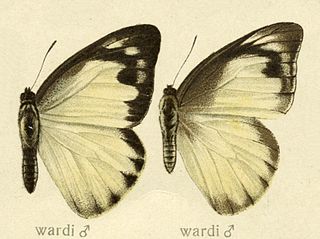
Appias wardii, the Indian albatross or Ward's albatross, is a small butterfly of the family Pieridae, that is, the yellows and whites, which is found in India.
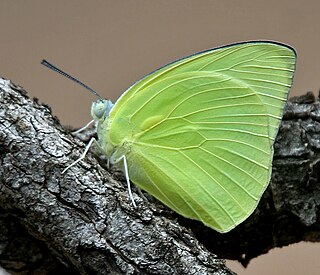
Catopsilia pomona, the common emigrant or lemon emigrant, is a medium-sized pierid butterfly found in Asia and parts of Australia. The species gets its name from its habit of migration. Some early authors considered them as two distinct species Catopsilia crocale and Catopsilia pomona.

Libythea myrrha, the club beak, is a butterfly found in India that belongs to the Libytheinae group of the brush-footed butterflies family found in the Indomalayan realm.

Curetis bulis, the bright sunbeam, is a species of butterfly belonging to the lycaenid family. It is found in Asia.
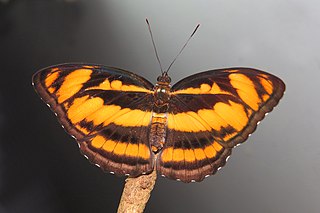
Athyma nefte, the colour sergeant, is a species of brush-footed butterfly found in tropical South and Southeast Asia.
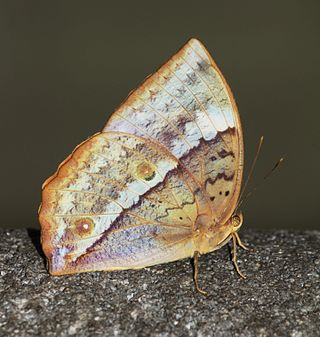
Discophora lepida, the southern duffer, is a butterfly found in Sri Lanka and south India that belongs to the duffers group, that is, the Morphinae subfamily of the brush-footed butterflies family.

The Indian fritillary is a species of butterfly of the nymphalid or brush-footed family. It is usually found from south and southeast Asia to Australia.

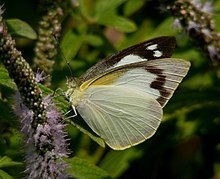





![aa[?]bttroosshlbhN.jpg](http://upload.wikimedia.org/wikipedia/commons/thumb/6/67/%E0%B4%86%E0%B5%BD%E0%B4%AC%E0%B4%9F%E0%B5%8D%E0%B4%B0%E0%B5%8B%E0%B4%B8%E0%B5%8D%E0%B4%B6%E0%B4%B2%E0%B4%AD%E0%B4%82.jpg/120px-%E0%B4%86%E0%B5%BD%E0%B4%AC%E0%B4%9F%E0%B5%8D%E0%B4%B0%E0%B5%8B%E0%B4%B8%E0%B5%8D%E0%B4%B6%E0%B4%B2%E0%B4%AD%E0%B4%82.jpg)



















